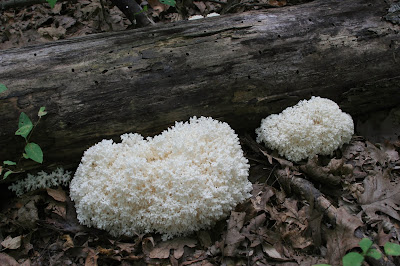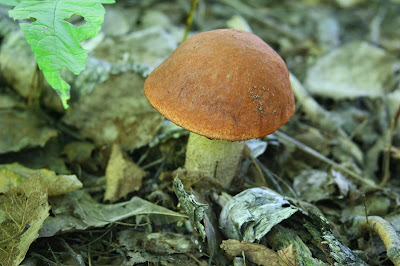Another interesting things about fungi, is that the mushrooms that we see are only a small part of a much larger organism. Most of a fungus is hidden in the ground, in dead logs, or even in living trees as a syetem of root-like fibers called mycelium. The mushroom that we see on the surface only occurs when the larger fungus is ready to reproduce by sending microscopic spores into the wind. Essentially a mushroom is a fruiting body produced by the large hidden mass of mycelium for the purpose of reproduction.
I am not an expert at identifying mushrooms. Of the people that are very good at identifying fungi, most of them learned because they like to forage for wild mushrooms. I don't particularly like to eat mushrooms (I don't dislike them, but they are not among my favorite foods), therefore I have never learned to identify very many different species. There are some species that are very easy to identify - I have already talked about puffballs, stinkhorns, and Chicken Mushrooms.
I do have several field guides that I can use to identify mushrooms.
From the left:
Lincoff, Gary H, 1981. National Audubon Society Field Guide to North American Mushrooms. New York: Alfred A. Knopf.
- I have written about my dislike for Audubon Field Guides when I wrote about choosing a wildflower field guide. My biggest criticism remains with the layout of having separate sections of pictures and text. They are excellent as a desk reference, but not nearly as friendly to use as a field guide due to the need to flip back and forth between pictures and text.
McKnight, Kent H., and Vera B. McKnight, 1987. A Field Guide to Mushrooms: North America (The Peterson Field Guide Series). New York: Houghton Mifflin Company.
- I generally like Peterson field guides, but this one is hard to use for the same reason as the Audubon guide - the pictures are separated from the majority of the text, making it more difficult to use.
Barron, George, 1999. Mushrooms of Northeast North America: Midwest to New England. Edmonton, Alberta: Lone Pine Publishing.
- I like the layout of this guide and think it is probably the easiest of the three to use overall for simple field identification due to the detailed pictures and descriptions on the same page. Here is a sample page. Once I have made an initial identification, I can go back to the Audubon or Peterson's guides.
 |
| Page from Mushrooms of Northeast North America by George Barron |
So let's look at some mushrooms!
 |
| Comb Tooth (Hericium coralloides) |
 |
| Fly Agaric (Amanita muscari) |
 |
| Shaggy Mane (Coprinus comatus) |
 |
| Bolete mushroom - possibly Orange Bolete (Leccinum aurantiacum) |
 |
| Turkey Tail (Trametes versicolor) |
 |
| Coral mushroom - possibly Crown Coral (Clavicorona pyxidata) |

Beautiful photos! I'm just getting started with fungi and can't wait for my morning walk tomorrow in the park. I'm assuming I'll only see bracket fungi at this time of year, but I do recall seeing a scarlet cup a few years back around this time.
ReplyDeleteI was hoping to purchase Barron's Mushrooms of the Northeast (about $35 used) but I see on amazon that a new edition is slated for March 1st. I really don't want to wait but why not. It will be updated and is even cheaper ($19.26)!
I am curious if the new edition will be different from the one I already have? If it is substantially updated or expanded I might have to spring for a new copy.
Delete